The Sinclair ZX81

The Sinclair ZX81, also marketed as the Timex Sinclair 1000 in the US, was a home computer introduced in the UK in 1981. It featured an 8-bit Zilog Z80 CPU (from which the name of the machine is derived) and just 1K of RAM. The ZX81 was not the first Sinclair computer product; it replaced the ZX80, which was released in January 1980, offering a number of fixes and improvements. However, it was ostensibly a mildly enhanced and cost-reduced version of the same machine. Prior to that, Sinclair had released the MK14 in 1977 which was intended as a computer training device for hobbyists. Both of these machines sold well. Slightly confusingly, Sinclair was actually two companies at the time as a result of financial difficulties. The more well-known computers were produced by the newer of the two Sinclair companies, originally known as Science of Cambridge. The original company, Sinclair Radionics, was simultaneously producing a different unrelated computer known as the NewBrain and had nothing to do with the ZX81. The NewBrain would be ultimately sold on to Grundy Business Systems and eventually saw a release in 1982 under that brand. Hence, the ZX81 was perhaps the 3rd or maybe 4th Sinclair computer depending on how you may account for them.
The ZX81 is often maligned as a poor quality computer even for the time, however this view underappreciates the cultural impact and the purpose that the machine served in the nascent home computer market. In 1981 the typical computer was generally a very expensive device, often only encountered in well-funded business and academia. For example, when the original IBM PC model 5150 was launched in the UK it was marketed at around £2900, a not inconsiderable sum even today, but in the early 80s this was the equivalent of over £10,000 with inflation to 2025 prices.
The significance of the ZX81 was not that it was a particularly capable machine or superior to other contemporary computers, it most definitely wasn't on either account, rather that it arrived with an unbeatable price tag of just £70. This is the equivalent of about £265 in 2025. If £70 wasn't cheap enough, the machine could be had for only £50 if you were capable of building it yourself. In previous years it had been a common proposition for a home computer to be delivered as a kit of parts with the assumption they would be purchased only by electronics enthusiasts and the buyer would have all the requisite test equipment and expertise. Note this is different to the modern concept of "building" a desktop PC where the parts slot together, in this era a computer kit meant you would be expected to solder each individual electronic component to a circuit board yourself. The ZX81 was just straddling the end of this period and the great majority of machines were now delivered as a professionally constructed appliance with the ZX81 amongst the final consumer machines to be available in this form.
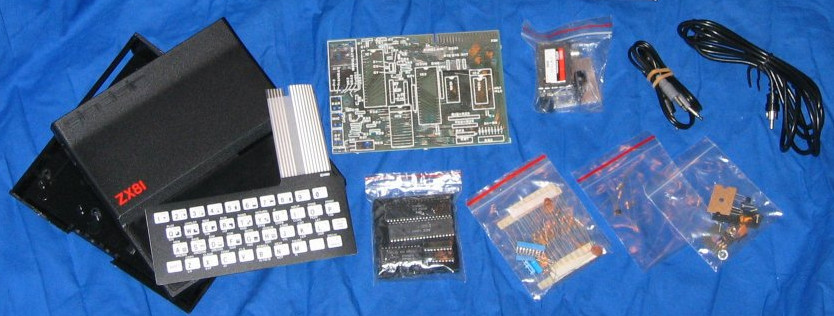
Other competing home oriented machines were available at plausibly home affordable prices in 1981 such as the Acorn Atom for £170 (about £716 in 2025), a Tandy TRS-80 for £312 (£1,180 in 2025) or perhaps a Commodore PET for £399 (about £1,510 in 2025) with a built-in monitor, but many people at the time were unsure of what capabilities a computer had or what uses one may be put to. The manufacturers often didn't present a particularly compelling sales pitch themselves as to why the general public might want a computer at home either. Of course, games would ultimately become the driving force behind home computer sales but vendors either didn't appreciate this or else were unwilling to suggest their instruments of scientific exploration were in fact most useful as toys. They instead touted such "exciting" use cases as storing your recipes, listing your stamp collection, managing your home accounts, keeping a diary and other mundane applications that could be achieved more effectively without a computer.
Most of the day-to-day applications that make a computing device a compelling purchase today, such as audio and video entertainment and network communication were either not feasible at home affordable prices or just not technically possible at all pending future inventions. It was unlikely that someone of modest means might be tempted to purchase one of these very expensive computer devices just on the off-chance it may prove useful in some as yet unknown way. Would you have preferred an IBM PC with no obvious practical use in the home or a nice car that you certainly did have a use for?
Another thing the ZX81 achieved was wide distribution in major national shop chains. It was available from release in W.H. Smiths, which was then a significant presence on the British high street and somewhere many people would visit at some point. Previously a computer available for purchase would appear only in a few specialist shops, of which there would probably not be one in your town, or more likely mail order was the only realistic option. These days the mail order (or web) buyer has the benefit of product videos, hundreds of products reviews, tutorials, blogs, opinion pieces and manuals all instantly accessible. However, in 1981 a computer may have to be purchased on the strength of a few words from the manufacturer in a magazine advert. Such a limited amount of information would represent a barrier to the purchase of a both unfamiliar and costly device, that is assuming the advert was even seen since they would usually appear in specialist electronics and computing magazines. By comparison being able to see the device in person whilst out on your weekly shop, and possibly even view it running, placed computing into the wider public consciousness in a way it had not been previously.
The affordability of the ZX81 combined with the easy retail availability put it within reach of ordinary people who might have had some passing interest in finding out what a computer could do. Many ZX81s probably ended up in a cupboard within the first year of use, but by then the machine had served its purpose as a gateway introducing computing to a public that had never had the opportunity to experience it before. Some would discover the joy of gaming, some found an interest in programming, but either way they would springboard from the ZX81 to a more feature rich machine. When buyers were hungry for more, Sinclair was ready with the more realistically capable 48K Spectrum, buoyed by the financial success of selling 1.5 million ZX81s. The Spectrum would go on to even greater heights.
The Z80 CPU used in the ZX81 is an enhanced variant of the Intel 8080, offering better performance and extra instructions. Running at 3.25Mhz it was not particularly slow relative to contemporary machines and delivered quite competitive performance. Even though it was released in 1976, the Z80 was such a widely regarded CPU it astonishingly remained in production largely in the original form until 2024 and modernised variants are still available. One aspect that limited the machine's performance was the way the the screen image was produced. The ZX81 relied heavily on the CPU for video rather than absorbing the added cost of a specialist video chip as most other computers did. An unusual feature, which is a consequence of the CPU based screen rendering, is the machine had a "slow" and "fast" mode. In slow mode, it would update the screen whilst running user software which significantly ate into the performance of the Z80, with possibly about 75% of the CPU being dedicated to the display requirements. In fast mode though, continuous screen updates are disabled which leaves most of the CPU performance available for running user software with the disadvantage of blanking the screen or producing an annoying flickering effect until the CPU operation is complete. However, a more serious limitation of the machine was in the provision of only 1K of RAM.
Memory was exceptionally expensive in the early 80s and a cost-cut machine was never going receive very much. Even so, 1K was a very low amount for the era compared with competing machines that usually had at least several kilobytes by this stage. Unfortunately a substantial chunk of the 1K was not even available to the user as some of the memory was needed for storing the display and more for system variables.
The display on the ZX81 was black & white only with no colour possible. Technically it displayed 256x192 pixels but the system did not have a native capability to make use of bitmap graphics in the traditional sense, it could only display characters on screen arranged as a grid of 24 rows of 32 characters. The available character set was quite limited offering only upper case characters and a few punctuation marks. It did however have a small number of graphics characters and games would mostly make use of these. It should be noted that it wasn't completely impossible to code bitmap graphics through clever programming although the mechanism by which this was achieved wasn't intentional in the ZX81 design. A variety of 3rd party adapters were produced that enabled an official bitmap graphics mode.
The Sinclair Spectrum, which succeeded the ZX81, would be so named to highlight that it now had a colour capability.
The display memory utilisation varied with what was shown on the screen. It could use anywhere from about 25 bytes with nothing displayed to 793 bytes with a full screen of 24x32 characters displayed (including a few bytes of overhead), so essentially nearly all of the memory could easily be consumed by the system leaving almost nothing for user programs. The use of variable portions of the memory depending on how much text was displayed on screen was a consequence of having insufficient RAM, adding complexity to the software managing the display, which caused it to be even slower in slow mode than if it had more memory.
If the user intended to make much progress with the ZX81 it would quickly become apparent that a RAM expansion was a necessary purchase and these were widely sold. Indeed a 16K RAM module, actually adding 15K of RAM + the 1K already present, was available right from launch sold alongside the machine. It was almost as if Sinclair expected users to need it! Upgrading to 16K made the machine a more viably useful computing device, but would set you back a further £50 as shown on this Sinclair mail order form from 1981. By only the following year, the typical cost of 16K RAM expansions had fallen to about £20 though.

Somewhat optimistically, the manual for the 16K expansion pack states: "...the computer can theoretically handle up to 960 [BASIC] program lines when fitted with this expansion pack. In practice, no program is likely to need this much."
Selling the largely essential RAM as an add-on may have been a little cheeky, but another way of looking at it was selling a computer in two halves. You could buy just enough of a functional machine to decide if computing was something that may be of interest to you and then purchase the remainder of the machine later, reducing the risk. Sinclair marketing wasn't shy of making this point either. Even with the additional memory pack it was still a significantly cheaper machine than most (or all) of the competition at the time of release.

The ZX81 displayed video via a UHF output for a domestic television to be used as the display. Computer monitors were an expensive peripheral in 1981 but most homes did have a television. UK TVs of the period did not often have many (or any) video inputs and in the typical case all that was available was a UHF connector to receive analogue television from a roof mounted antenna. As was common with many home micros of the period, the ZX81 would effectively broadcast on a spare TV channel via a cable attached to the aerial input. This was a guarantee that it would work with every television and acted as a lowest common denominator form of video interface. Given the low resolution of the machine, this was good enough. With analogue television being a thing of the past, this can present a challenge if attempting to connect a ZX81 to a modern television. Either the ZX81 must be adapted to output another signal or a device must be used to convert an analogue signal to HDMI.
Data storage was via cassette tape, there were no other interfaces included. The user would connect a domestic analogue tape recorder (which many households would own at this time) via the headphone and microphone socket. Data was stored as a series of rapidly alternating sounds on the tape. Floppy disks (mainly 5.25") were a widely available data storage medium in 1981 but the cost of the drives was steep. The disk interfaces for the machine were also a considerable expense. The omnipresent USB now ensures device connectivity is ubiquitous, cheap and standardised but in the early 80s things were not so easy. Each device would often require a specialist connection and inclusion of a disk interface, a relatively complex piece of electronics, could not be guaranteed and certainly not on a computer built to a price. Even relatively expensive machines didn't include any kind of interface for a disk drive and it was an additional cost to the base machine.
This advert from Aerco (found in Sync magazine from Nov 1982, provides an insight into why disk drives were not common for the ZX81. It lists a 5.25" disk drive as costing $189, with an additional $69 required for the power supply and a further $179 for the disk interface electronics necessary for connecting it up. The total cost of the equipment was therefore $437, several times the cost of the ZX81 itself, the US variant of which was sold from release for $100 and rapidly discounted further.
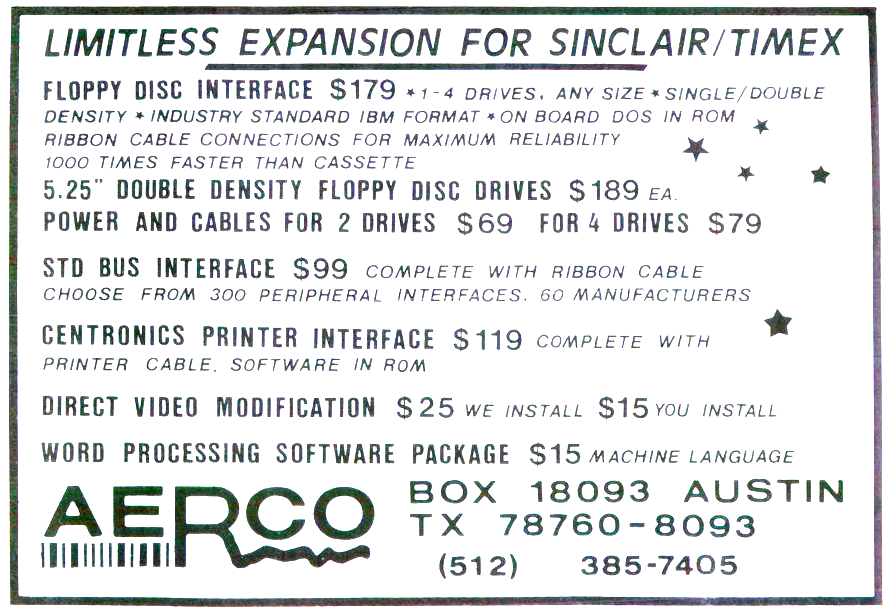
Given the market positioning of the ZX81 as an introductory computer, disk drives were never going to be a common option. This would also be the case with most competing home computers in the UK in the early to mid 80s. While it may seem astonishing now, even the first IBM PC included a cassette interface for fear that users may balk at the the high cost of a disk drive, although this was removed on later models.
Cassette tape wasn't an ideal storage medium by any means. It was exceptionally slow, with the ZX81 interface operating between about 250 - 400 baud (bits per second) depending on exactly what was stored. Using a 1K system it might take under a minute to fill the memory from a tape, but a 16K system could test the patience of the user as they could be waiting 5 - 10 minutes. Later systems would use faster tape interfaces but even so as memory sizes grew, loading times from tape would become a limitation.
Tape was also unreliable. Modern error correction techniques now make intrinsically unreliable transmissions mediums (like wi-fi) highly reliable but this was far too complex for the ZX81 and it had no capability in this regard. If it failed to hear part of the program correctly on the tape, that was the end of the matter and frustratingly the user had to start loading it again from the beginning. The tape player, being a mechanical device, might not be playing at a consistent speed or the tape might be stretched. The user would also be expected to set the tape player volume correctly to match the finicky expectations of the ZX81 which was not always easy.
Vinyl record players were still in widespread use for music in 1981 and some magazines distributed software on inexpensive bendable records called "flexi discs" that were bound within the pages. Software stored on a record could be played into the ZX81 microphone input just like a cassette tape. Another common option for magazine software distribution was the magazine would simply print the program listing and the user would type it in. Programs for low memory machines were small enough that they could be feasibly manually typed by a patient user in a reasonable amount of time. In later years, cassette duplication would become cheap enough that tapes were routinely given away free with magazines.

With disk drives too expensive for the price sensitive buyer, despite the considerable limitations, tape would have to do. It would take until the second half of the 80s for disk to become cheap enough for cassettes to be displaced as the dominant storage medium for the home. In business and education, disk drives were of course widely used and other countries saw a different picture.
An area where the ZX81 was widely criticised was the membrane keyboard which provided no tactile feedback and was difficult to type on. Acceptable keyboards are now a very low cost commodity item but at the time the ZX81 arrived they were a large expense. Most home computer manufacturers had to find some way to produce a cost-cut keyboard as opposed to buying in an off-the-shelf commercial offering and some succeeded better than others. Many third party manufacturers soon appeared to offer improved alternative keyboards for the device.
The ZX81 was shipped with the BASIC programming language in ROM. This was becoming the de facto standard programming language for home micros at the time and it was a convention that a machine would boot into a BASIC prompt on start. Many manufacturers chose to license Microsoft BASIC (often calling it something else) but Sinclair did not and commissioned their own version from a company called Nine Tiles Information Handling. The software was largely written by Steven Vickers with some code recycled from the preceding ZX80 ROM developed by John Grant. The ZX81 BASIC introduced a few new features not present in the ZX80 such as floating point support and trigonometric functions. It was about as functional as could be hoped with apparently only 1 byte being left unused in the ROM.
The keyboard layout for the ZX81 is quite novel and is directly tied to the BASIC.
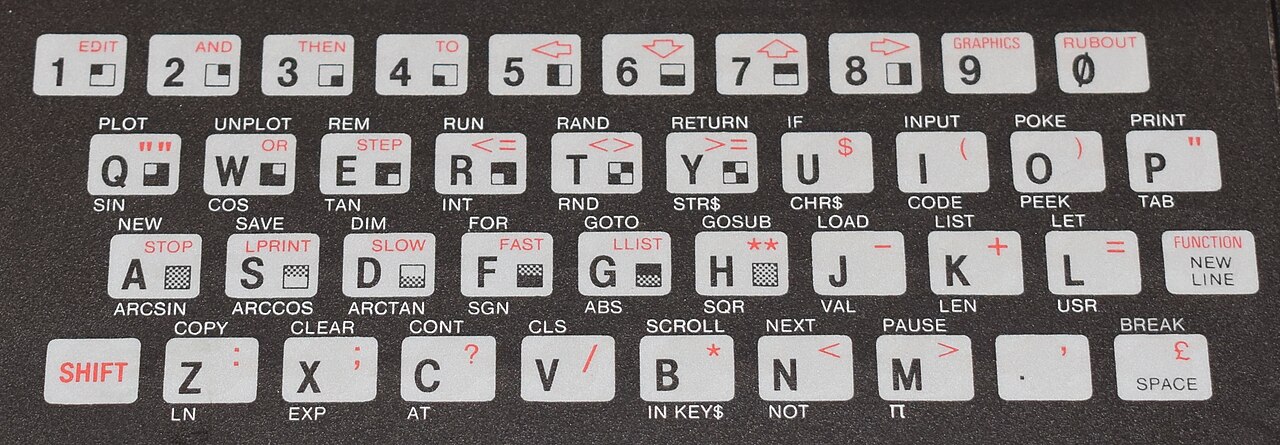
BASIC commands on the ZX81 were not typed one character at a time. Pressing the relevant key actually produced the whole command at once as was printed on the key. For example pressing the "P" key would produce the BASIC keyword "PRINT" instead of the user typing out the individual letters P-R-I-N-T. Following the keyword, the keyboard would operate more conventionally where pressing one key would produce one letter. The prompt on the display would change depending on the mode in which the keyboard was operating. It would display "K" where pressing a key would produce a whole BASIC keyword and "L" where you could freely type one letter at a time.
Reports vary as to why Sinclair used this unusual system of typing given that few (or no) other computer manufacturers did. One suggestion was that since the ZX81 keyboard was not great, the mechanism would help reduce key presses. Another variation on the same theme was the suggestion that the average customer would not know how to type, having likely never used a computer previously, and this would assist them. A recollection from John Grant was that it was found to be too difficult to fit a full BASIC keyword parser into the smaller ROM chip of the ZX80 predecessor and the method of typing was carried forward into the ZX81, continuing to save space which was at a premium.
The ZX81 would use one byte of RAM to represent one character but not all of the 256 available code points in a byte were required for characters and so some of the values were used to represent BASIC keywords. Representing keywords as a single character reduced the amount of the memory each occupied. When the user pressed a key with a BASIC keyword printed on it, the keyboard would produce the relevant code number for the keyword in the ZX81 character set. This in effect meant the user parsed the keywords themselves as a side-effect of typing them in, obviating the need for parsing code.
One of the key enablers for the low price point of the ZX81 was that it consisted of only four chips (or five on some boards). There was a 1K memory chip (or two half kilobyte chips), an 8K ROM chip, the Z80 CPU and a component called an Uncommitted Logic Array (ULA) which had several functions. The preceding ZX80 contained 21 chips and the purpose of the ULA was to mop up many of these and roll them into into a single device. Designs with fewer chips are generally cheaper as there are not as many chip packages, each of which costs money, the circuit board can be smaller and there is less assembly needed.
One anecdote suggests the ZX80 was a reaction to problems with the unreliability of ULA technology in 1980 and the ZX81 was released when these issues were solved the following year.

ULAs, also known as gate arrays, were a relatively new concept when the ZX81 was released and were an idea to reduce chip production costs. The design process for chips at this time was complex and labour intensive with most being bespoke designs produced by specialists. A ULA made the process of designing and manufacturing chips cheaper by presenting the designer with an off-the-shelf component containing a kit of standardised parts formed into a grid that could be connected together as preferred. The ULA developer would effectively supply a wiring diagram for the component grid to the ULA manufacturer who would apply this to their existing chip design. A photo of the surface of the ULA used in the ZX81 is shown below and the grid pattern of the components can be seen:
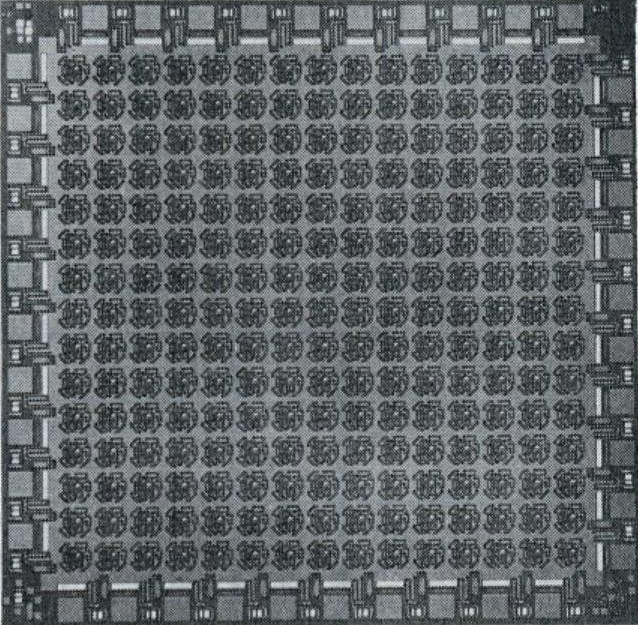
A ULA is somewhat similar to the idea of a modern FPGA chip, except that an FPGA can be repeatedly re-programmed by the developer with different circuit designs whereas a ULA cannot and the design is permanently fixed when it is manufactured. This is like the distinction between flash memory and ROM.
At the time British company Ferranti were a leading manufacturer of ULAs and a Ferranti 2C184E (or 2C210E) part was used in the ZX81. This was a low-end component and Ferranti also produced parts by this time that could handle much larger numbers of logic gates, but of course they were much more expensive and the ZX81 aimed to use the cheapest one possible. This chip contained 225 "cells". Each of these cells contained three transistors that could assume the function of different types of logic depending on how they are wired up. It was possible to realise the function of perhaps around 300 - 400 logic gates with this series of devices depending on exactly how cleverly the design utilised the cells.
The ZX81 ULA design was produced by Jim Westwood and Richard Altwasser. Amazingly the chip was designed without computer technology, although CAD software for chip design was becoming available by this time. It is now largely infeasible to design a chip without CAD but at the time they were simple enough that it could be still be done on paper.
Despite the limitations of the stock 1K ZX81, clever programmers did manage to squeeze some impressive software into this tiny amount of RAM. Perhaps one of the most amazing was 1K Chess by David Horne, which achieved a functional chess computer in only 672 bytes of RAM.
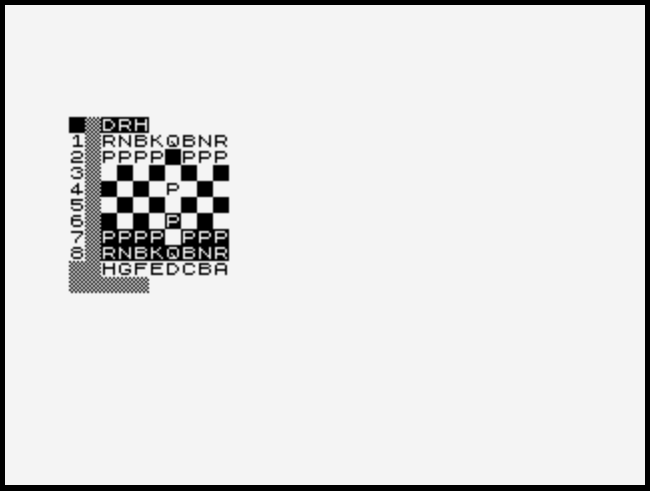
Programming for 1K is an even more impressive feat when it is considered that the program code had to be held in RAM simultaneously with the program variables and video display. Note how the chess board above is inconveniently placed on the left side of the screen instead of being centred because it requires less display RAM to position it there, leaving more memory available for the program.
Other machines of the era with little RAM most usually used cartridge based games where the game code is held in a 4K or greater size ROM chip. The ROM is able to run at the same speed as RAM and is read in the same way. This effectively provides several kilobytes of additional memory with the disadvantage that the ROM chip is expensive to manufacture compared with the cassette tape format used by ZX81 games. Not unexpectedly though, the majority of quality titles for the ZX81 did lean towards requiring the 16K expansion pack.
Perhaps one of the most memorable ZX81 games (16K) was 3D monster maze published by J.K. Greye Software (coded by Malcolm Evans). The player traverses a 3D maze being hunted by a dinosaur. The aim is the find the exit to the maze before the dinosaur catches you. It somehow achieved a reasonable 3D effect with the constraints of the very limited graphics capability of the machine.

Another well reviewed title from the same publisher is 3D defender. This is a first-person space combat game where the player must defend their planet from alien spacecraft by flying over the surface and destroying them. The game features a radar system that helps the player locate enemy ships in close proximity.

Rocket Man is a platform game by Software Farm for the ZX81 which makes use of software tricks to generate bitmap graphics, bypassing the limitation of character based graphics. It required a standard Sinclair 16K adapter but no other special hardware.
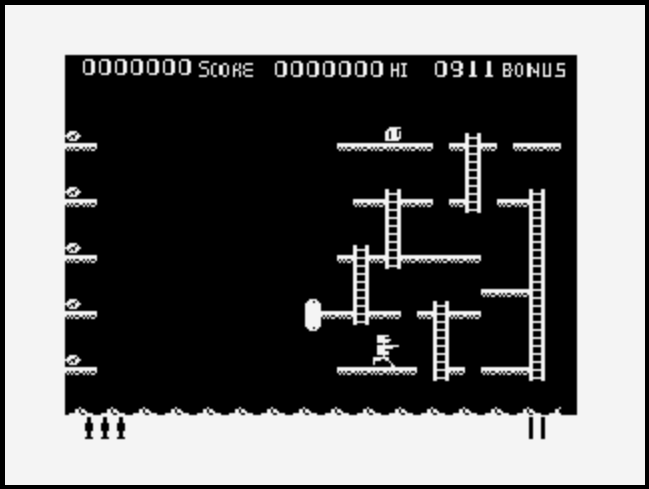
Within a year, more advanced and affordable machines became widely available, including those from Sinclair. The market evolved rapidly, but the ZX81 played a crucial role in introducing computing to the British public.
Image Credits: ZX81, by Journey234, Public Domain; ZX81 Kit, by Smaddison, Creative Commons Attribution-Share Alike 3.0; RAM Pack, by Ubcule, Public Domain; ZX81 Keyboard, by Piergiovanna Grossi, Creative Commons Attribution-Share Alike 4.0; Flexidisc, by Swtpc6800, Public Domain; ZX81 Main Board, by Journey234, Public Domain
